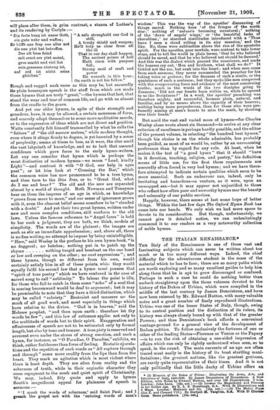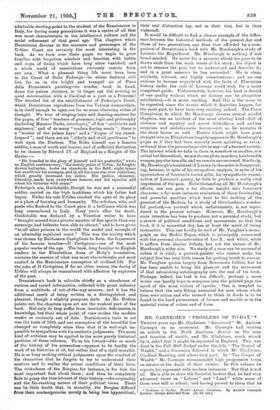THE ITALIAN RENAISSANCE.*
THE Italy of the Renaissance is one of those vast and fascinating subjects which can never be written about too much or in too many different ways. Indeed, the chief difficulty for the adventurous student is the mass of the material which he has to face; there are so many paths which are worth exploring and so many excellent guides to help him along them that he is apt to grow discouraged or confused. Perhaps in such a case lie could do nothing better than embark straightway upon the three volumes devoted to the history of the Dukes of Urbino, which were compiled in the middle of the last century by James Dennistoun, and have now been reissued by Mr. Edward Hutton, with many valuable notes and a great number of finely reproduced illustrations. Urbino was one of the lesser States of Italy, though, owing to its central position and the distinction of its rulers, its history was always closely bound up with that of the greater Powers; and thus Dennistoun's book affords a convenient vantage-ground for a general view of the development of Italian politics. To follow exclusively the fortunes of one or other of the leading States—Florence or Venice or the Papacy —is to run the risk of obtaining a one-sided impression of affairs which can only be rightly understood when seen, so to speak, in the round. The main currents of an age are often traced most easily in the history of its least startling mani- festations; the greatest nations, like the greatest geniuses, are rarely quite representative of their times. And it is not only politically that the little duchy of Urbino offers an • (1) Memoirs of the Dukes of Urbino: Illustrating the Arms, Arts, and Literature of Italy, 1440-1830. By James Dennistoun of Dennistoun. A New Edition, with Notes by Edward Hutton, and over 100 Illustrations. 3 vols. London : John Lane. [42s. net.] — (2) Lorenzo the Magnificent, and Florets** in her Golden Ago. By E. L. S. Horaburgh. B.A. With 24 Illustrations and 3 Maps. London : Methuen and Co. [15s. net.]—(3) The Medici Popes (Leo I. and Clement VII.) By Herbert hi. Vaughan. B.A. With 20 IlInstaxe tions. Same publishers. E153. net4
admirable starting-point to the student of the Renaissance in Italy, for during many generations it was a centre of all that was most characteristic in the intellectual culture and the social refinement of that great age. The chapters which Dennistonn devotes to the manners and personages of the Urbino Court are certainly the most interesting in the book. As we turn over these pages we begin to grow familiar with forgotten scholars and beauties, with habits and ways of living which have long since vanished, and a whole world of associations curiously remote from our own. What a pleasant thing life must have been in the Court of Duke Federigo—he whose features still live for us in the bright and tranquil air of Piero dells Francesca's painting—to wander, book in hand, down the palace cloisters, or to linger out the evening in quiet oonversation with a Cardinal or a poet or a Princess !
The detailed list of the establishment of Federigo's Court, which Dennistoun reproduces from the Vatican manuscripts, is in itself enough to open out for us some charming vistas of thought. We hear of singing-boys and dancing-masters for the pages, of four" teachers of grammar, logic and philosophy (including Maestro Paolo, astrologer)," of five "architects and engineers," and of as many "readers during meals "; there is a "master of the palace keys," and a "keeper of the camel- leopard "; and there are six "elderly and staid gentlemen" to wait upon the Duchess. The Duke himself was a famous soldier, a man of worth and honour, and of sufficient distinction to be chosen by Edward IV. of England as a Knight of the Garter :—
"He founded to the glory of himself and his posteritie," wrote an English contemporary," the stately police of Urbin ; he foughte dyvers battayles ; tooke six standerds in the field ; eight tymes bee overthrew his enemyes, and in all his wars was ever victorious, which greatly increased his riches. His justice, clemency, liberality, made hym everywhere famous, and did equalize and adorn his victories with peace."
Federigo's son, Guidobaldo, though he was not a successful soldier, carried on the high traditions which his father had
begun. Under his rule Urbino reached the apex of its glory as a place of learning and humanity. The scholars, wits, and poets who flocked to the Court gave it a brilliance which was long remembered in Italy. Sixty years after his death, Guidobaldo was declared by a Venetian writer to have "brought around him a greater number of fine spirits than any sovereign had hitherto been able to attract," and to have given "to all other princes in the world the model and example of
an admirably regulated court." This was the society which was chosen by Baldassare Castiglione to form the framework of his famous treatise—Il Cortegiano—one of the most
popular works of the age. The book, long familiar to English readers in the Elizabethan dress of Hoby's translation, contains the essence of what was most characteristic and most
exalted in the Renaissance conception of civilised life. For the sake of 11 Cortegiano, if for no other reason, the duchy of Urbino will always be remembered with affection by explorers
of the past.
Dennistoun's book is valuable chiefly as a storehouse of curious and varied information, collected with great industry from a multitude of out-of-the-way sources ; and it has the additional merit of being written in a distinguished and pleasant, though a slightly pompons, style. As Mr. Hutton points out, the chapters upon art are the weakest part of the book. Not only do they suffer from inevitable deficiencies in knowledge, but their whole point of view strikes the modern reader as curiously out of date. Dennistoun's taste in art was the taste of 1850, and our conception of the beautiful has changed so completely since then that it is well-nigh im- possible to sympathise with his aesthetic judgments. The same kind of criticism may be applied to the more purely historical portions of these volumes. To us his history—like so much
of the history of his generation—appears to be hardly the work of an historian at all, but rather that of a rigid moralist.
He is so busy making ethical judgments upon the conduct of his characters that he forgets to try to understand their motives and to realise the actual conditions of their lives.
The wickedness of the Borgias, for instance, is for him the most important fact about them ; and thus he completely fails to grasp the true interest of their history,—the originality and the far-reaching nature of their political views. There can be little doubt that, in morality, the Borgias differed from their contemporaries merely in being less hypocritical; their real distinction lay, not in their vice, but in their statecraft.
It would be difficult to find a clearer example of the differ- ence between the historical methods of the present day and those of two generations ago than that afforded by a com- parison of Dennistoun's book with Mr. Horaburgh's study of Lorenzo the Magnificent. Mr. Horsburgh is nothing if not broad-minded. He never for a moment allows his gaze to be drawn aside from the main issues of his story ; his object is not to censure the past, but to understand and describe it; and in a great measure he has succeeded. He is clear, scholarly, tolerant, and highly conscientious ; and no one anxious to become acquainted with the facts of Florentine history under the rule of Lorenzo could wish for a more competent guide. Unfortunately, however, his book is devoid of one quality without which no history can be altogether satisfactory,—it is never exciting. And this is the more to be regretted since the events which it describes happen, for the most part, to have been very exciting indeed. The Pa zzi Conspiracy, to which Mr. Horsburgh devotes several careful chapters, was an incident of the most stirring kind—full of violence and mystery and secret wickedness and sudden surprises and melodramatic horror—yet as he narrates it the story leaves us cold. Events which might have gone straight into an Elizabethan tragedy appears in Mr. Horsburgh's pages as if they had been scarcely more agitating or extra- ordinary than the proceedings—let us say—of a learned society. The interest which we take in them is, somehow or another, not actual but theoretical; we are shown plots, murders, hairbreadth escapes,popular tumults, and we remain unconcerned. Similarly, Mr. Horsburgh's treatment of Lorenzo's character is disappoint- ing, because, in spite of his scrupulous analysis, in spite of his appreciation of Lorenzo's varied gifts, his sympathetic exami- nation of Lorenzo's poetry, be fails to produce a really vital impression of the pan. Notwithstanding all Mr. Horsburgh's efforts, one can gain a far clearer insight into Lorenzo's character, a far more intimate realisation of those fascinating and powerful qualities which went to the making of the greatest of the Medicis, by a study of Ghirlandaio's wonder- ful portrait,—a portrait which, unfortunately, is not repro- duced in the present volume. However, Mr. Horsburgh's main intention has been to produce, not a personal study, but a sketch of political conditions and movements, so that his book, if it is somewhat dry, has at least the merit of being instructive. This can hardly be said of Mr. Vaughan's mono- graph on the Medici Popes, which is principally concerned with the personal characteristics of Leo X., and which, while it suffers from similar defects, has not the excuse of Mr. Horsburgh's wider aim. No study of a man can be successful unless it is vital; a portrait-painter who cannot make his subject live has very little reason for putting brush to canvas. Mr. Vaughan quotes largely from Benvenuto Cellini, but be has been unable to bring the glamour and the movement of that astonishing autobiography into the rest of his book. Perhaps, indeed, his task is too difficult; perhaps a mere writer can hardly hope to compress into the printed page the spirit of the most violent of epochs. One is tempted to believe that the only fitting memorial for men whose whole lives were action and who seemed to think in deeds is to be found in the hard permanence of bronze and marble or in the material vision of colour and of form.

































































 Previous page
Previous page